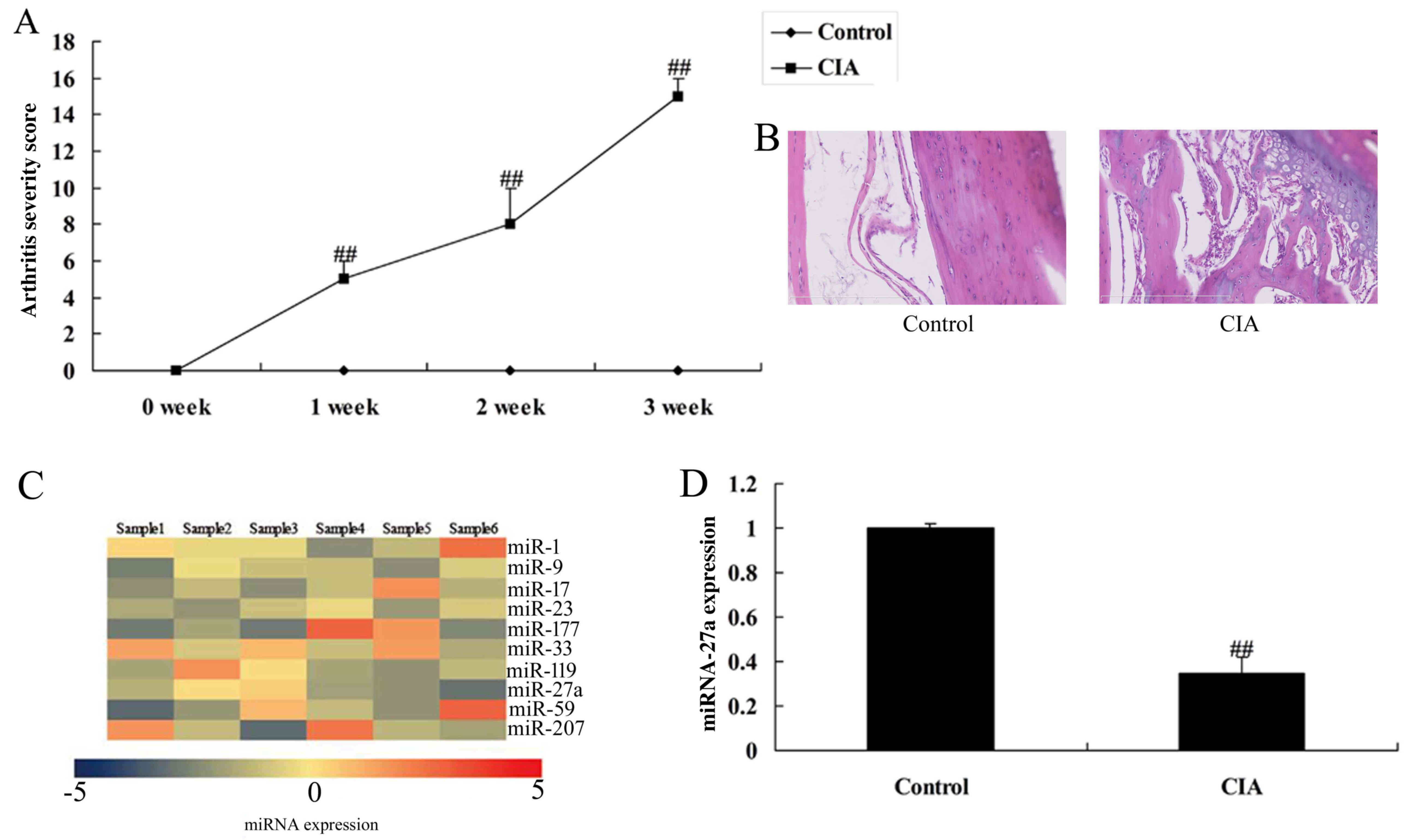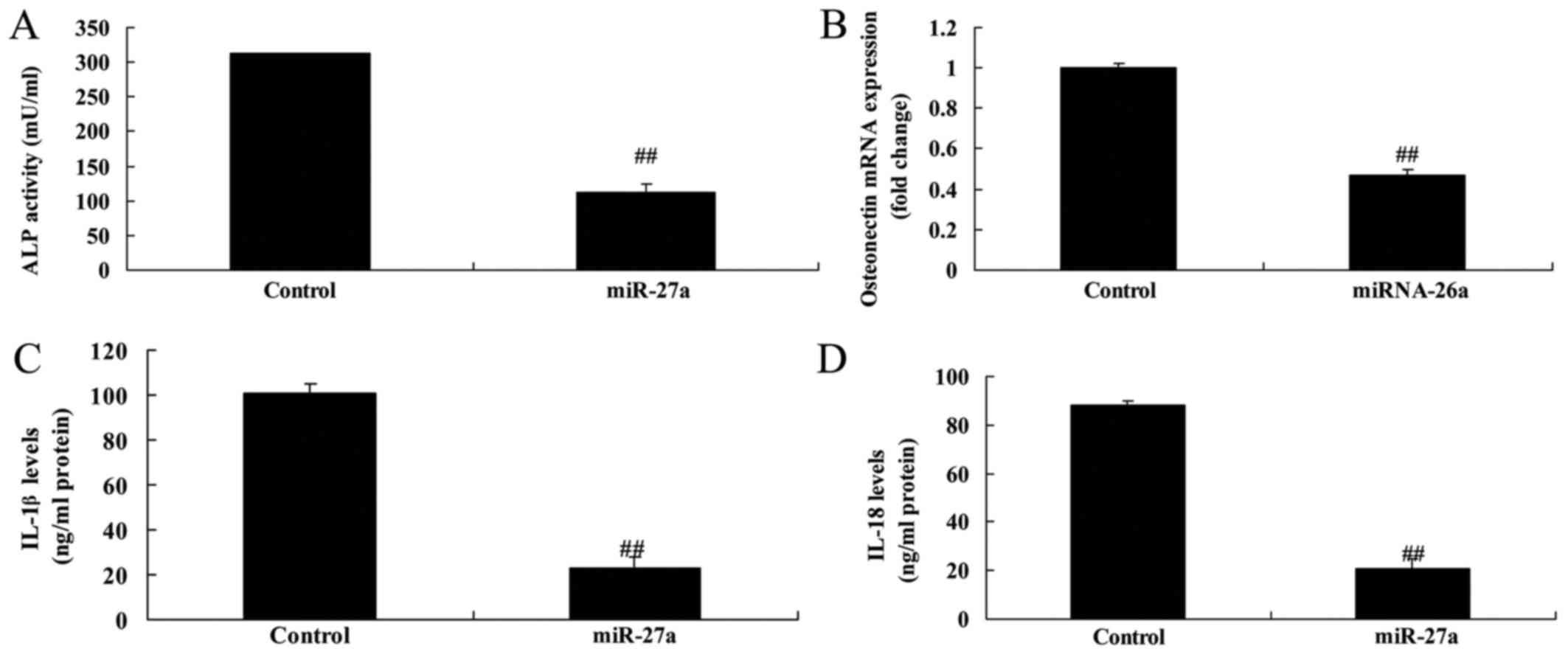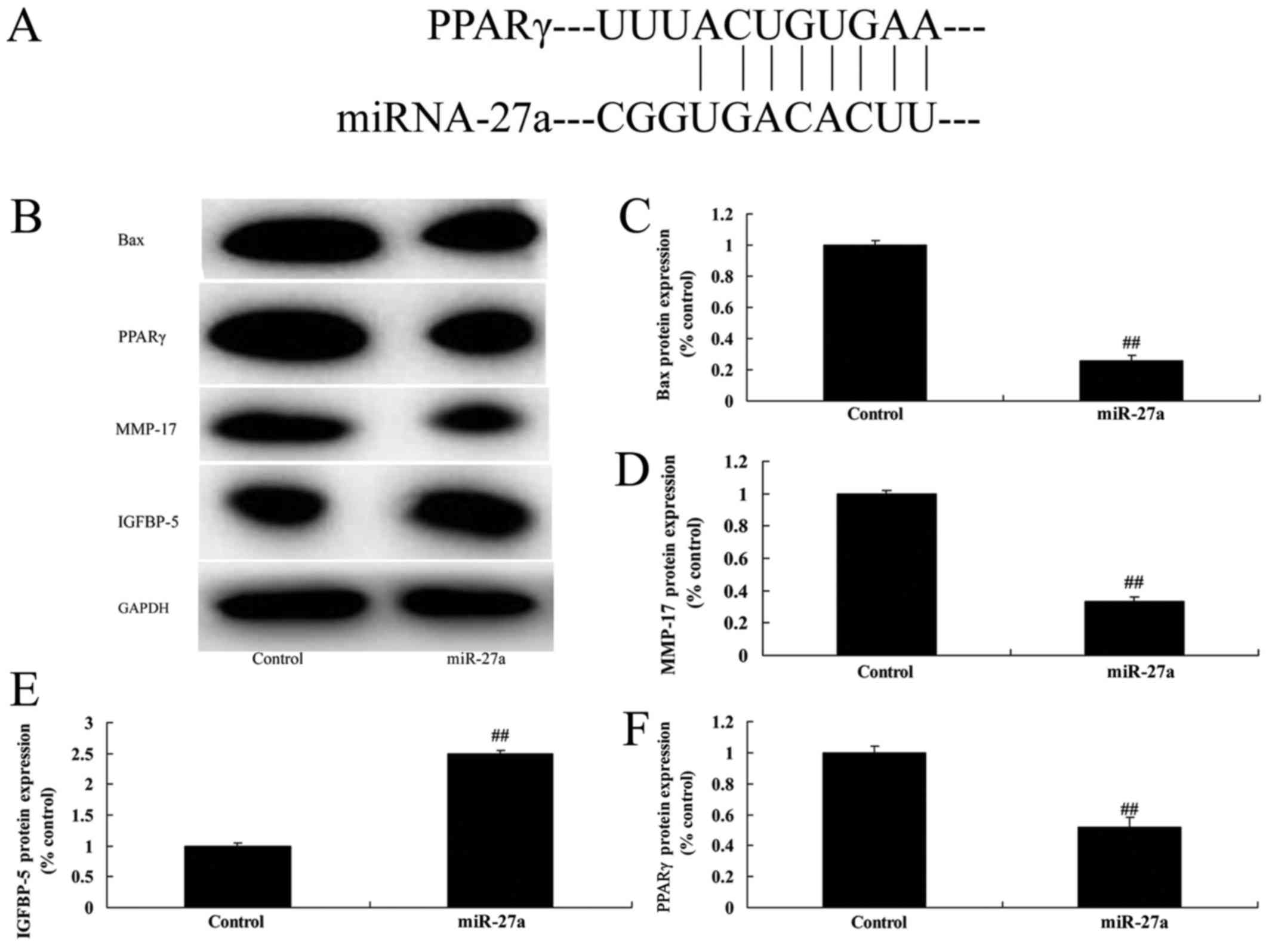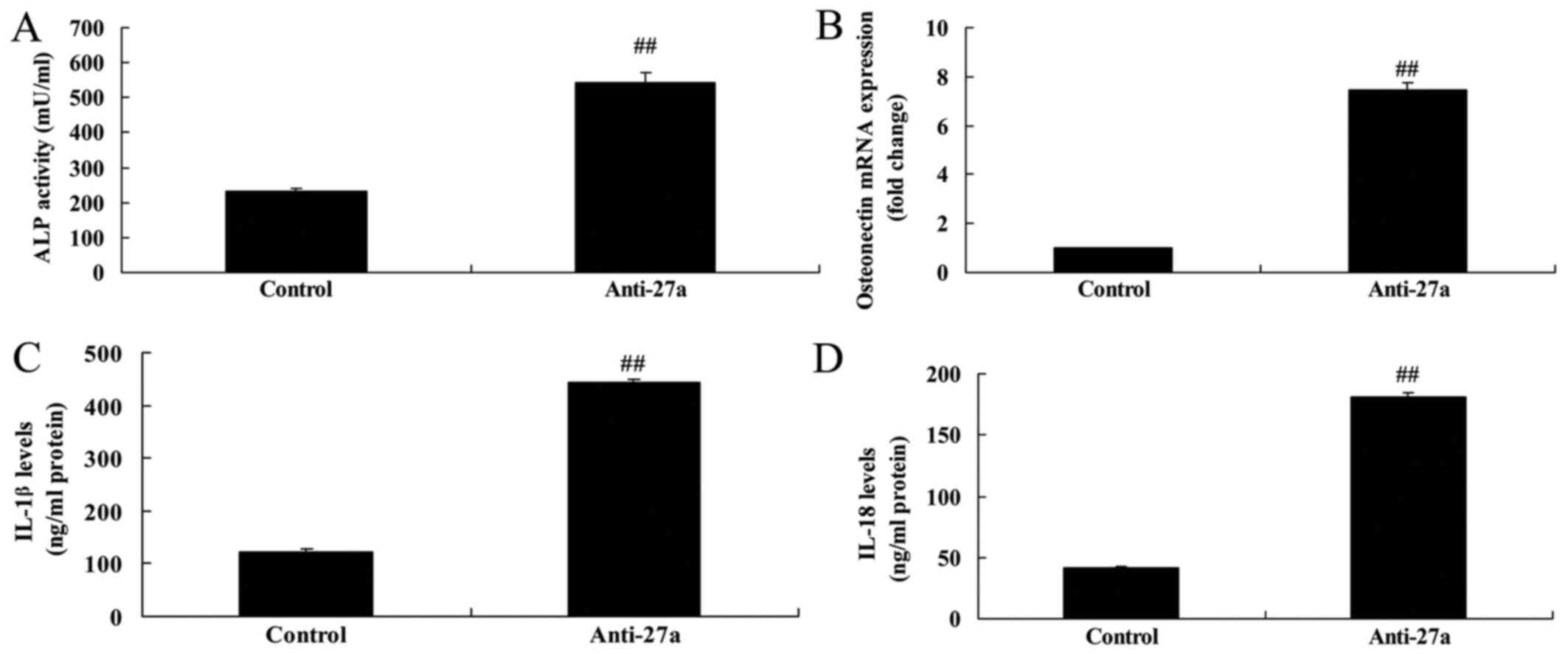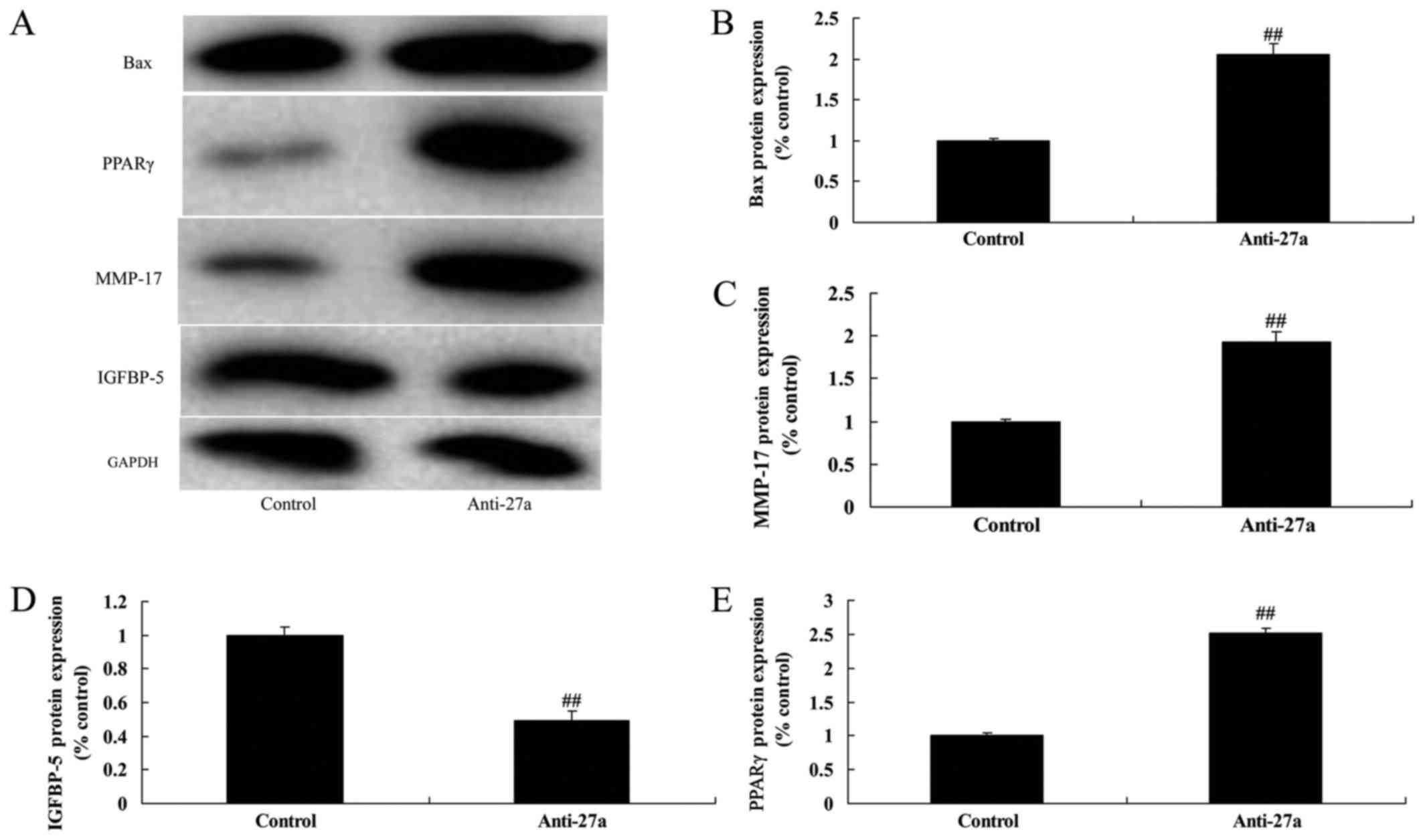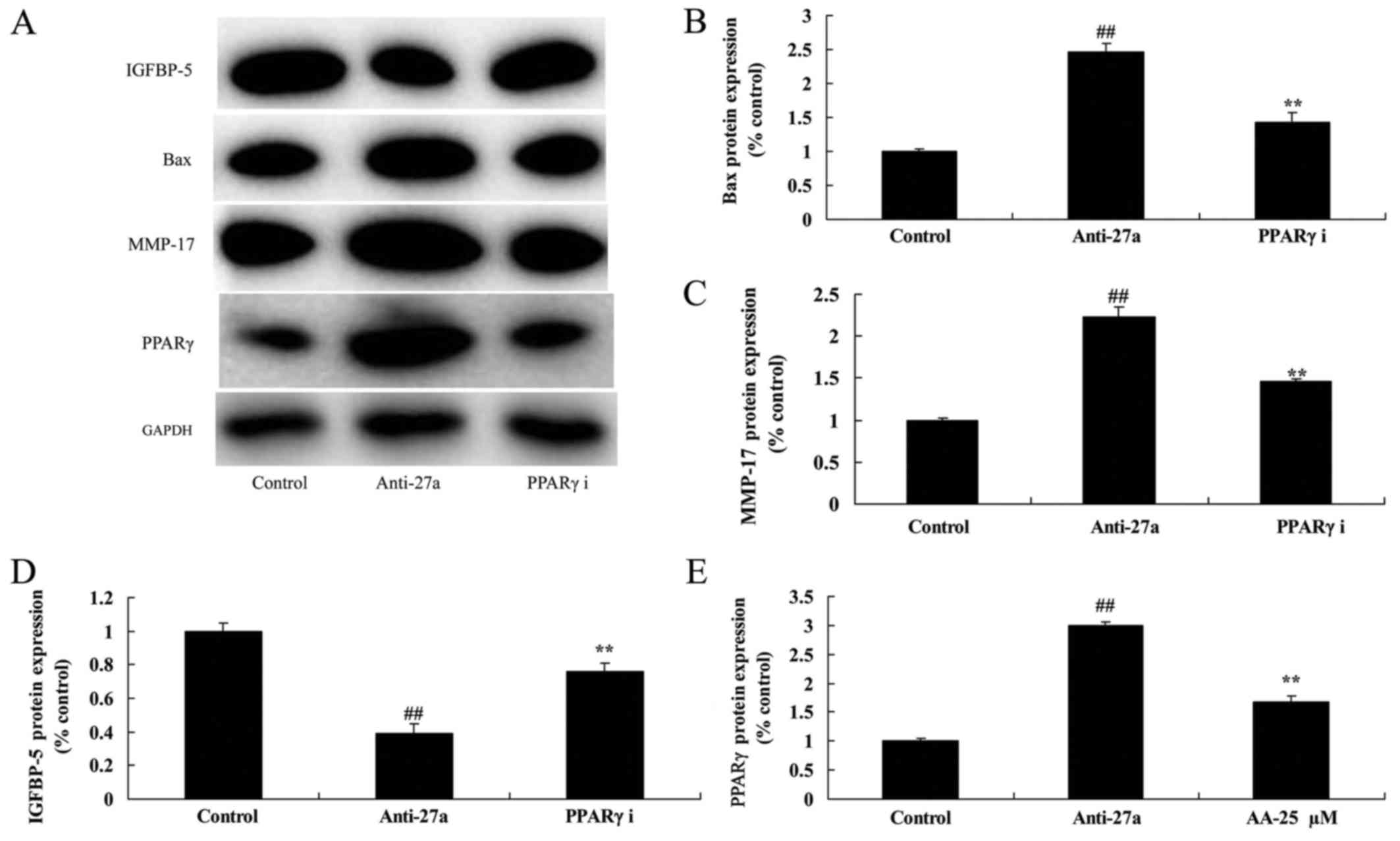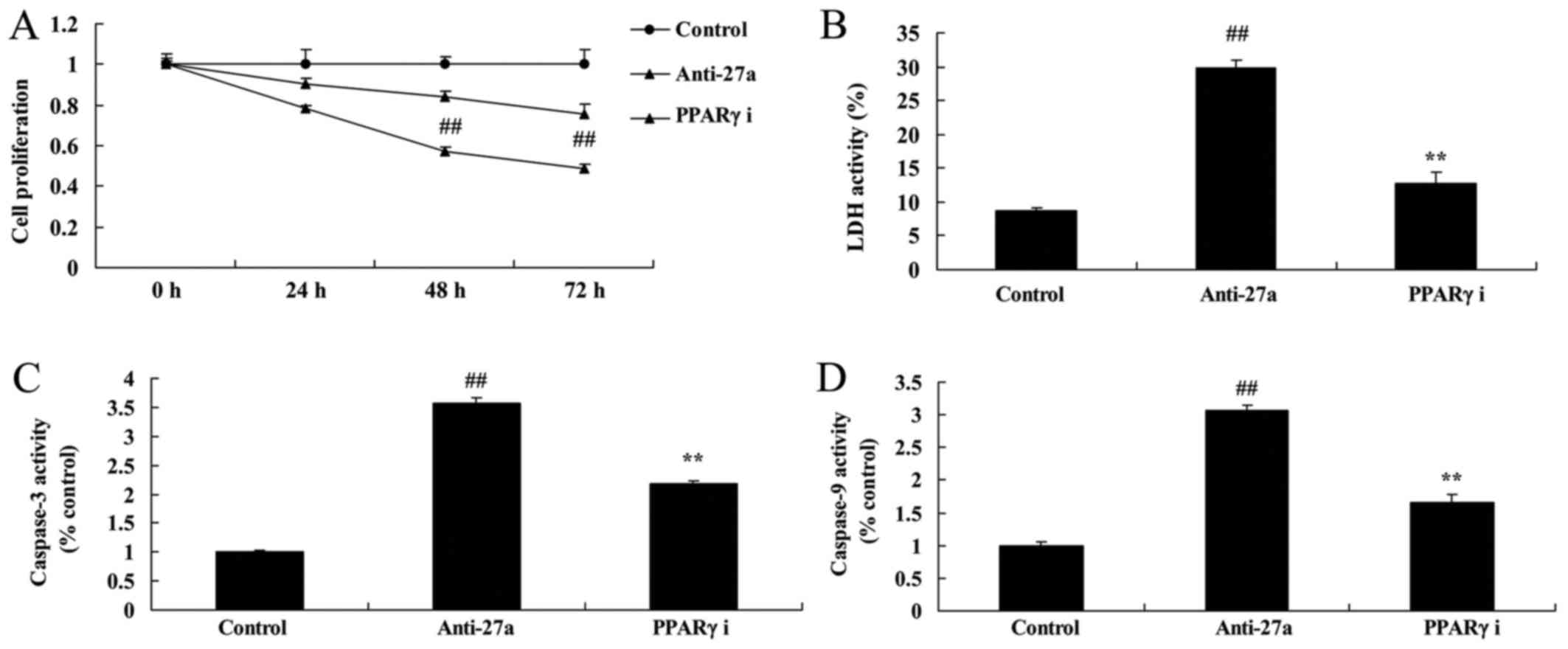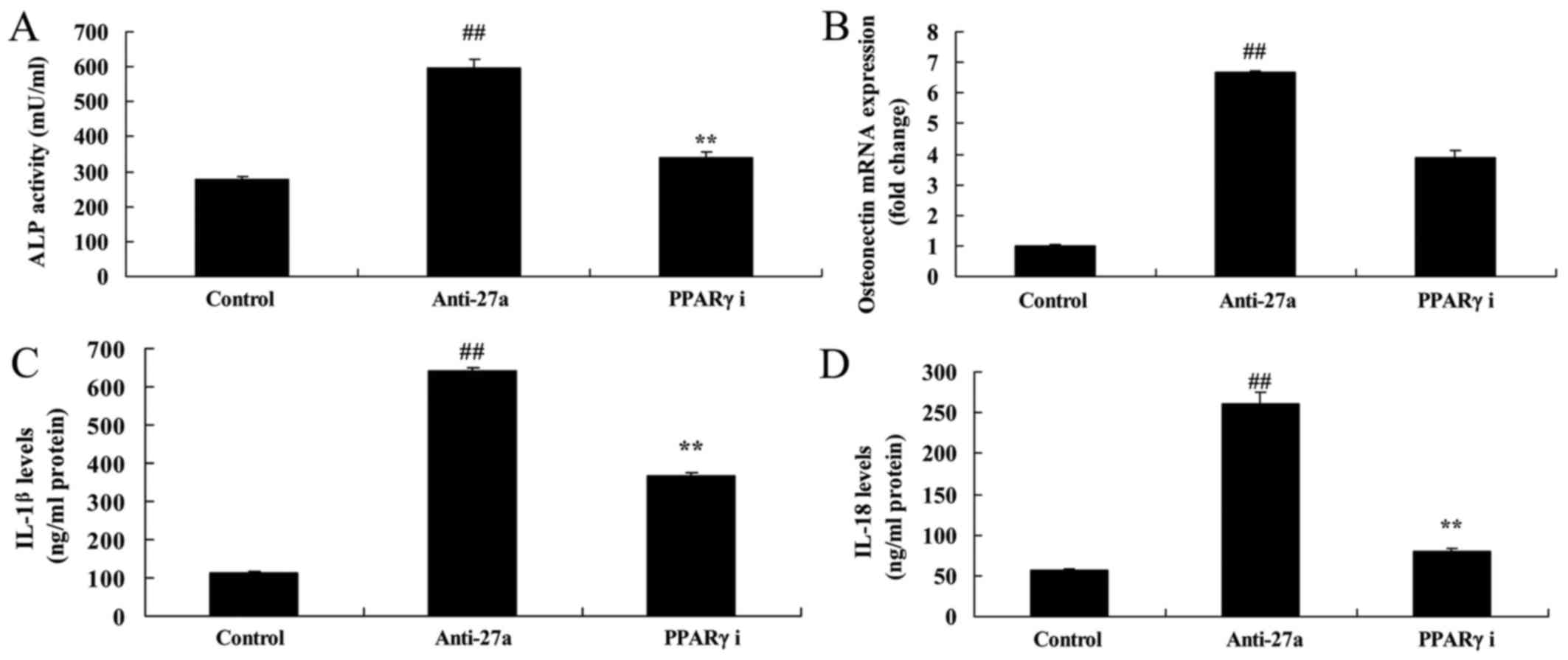miRNA‑27a regulates arthritis via PPARγ in vivo and in vitro
- Authors:
- Published online on: January 31, 2018 https://doi.org/10.3892/mmr.2018.8531
- Pages: 5454-5462
Abstract
Introduction
Osteoarthritis is a common and frequently occurring disease in orthopedics (1). The main pathological manifestations include articular cartilage degeneration, joint edge and subchondral bone hyperosteogeny (2). OA is one of the most serious arthrosis diseases that affect the health and life of human beings (3). It is more common in the middle and old aged people over 50 years old, seriously endanger the physical health of middle-aged and elderly people and affect their life quality. Also, it causes heavy burdens for individuals, families and the society (1).
miRNA is a single stranded non-coding RNA containing 19–25 molecules, commonly existing in plants, animals, and microorganisms, and involving in regulating a variety of physiological activities in the body (4). In 1993, the first miRNA was found in Caenorhabditis elegans (5). miRNA has a wide range of biological functions in the body, and can participate in the regulation of many physiological activities, including cell division, differentiation, apoptosis and organ formation. The research on the function of miRNA has become a hot topic in the field of life science. The expression of miRNA is strictly regulated by the body, and has strict time specificity and tissue specificity (5). Meantime, the biological function of miRNA is also strictly regulated. Studies have shown that many miRNAs play an important role in the regulation of OA (6). Through gene chip and in situ hybridization, we found that the expression of nine miRNAs such as miRNA-483, miRNA-22, and miRNA-377 were significantly up-regulated in OA of human knee joint, and the expression of seven miRNAs was obviously downregulated (7).
Matrix metalloproteinases (MMPs) are synthesized by synovial and cartilage cells (8). They play a decisive role in the imbalance between extracellular matrix synthesis and degradation of osteoarthritis (OA) articular cartilage (8). Therefore, MMPs play a key role in OA. Its pathological function is mainly tissue degradation in OA (8). MMP-17 is one of the MMPs gene family members (9). It has strong matrix degradation activity and extensive subtract specificity. These substrates include type IV collagen, laminin, fibronectin, proteoglycans, type I gelatin and soluble elastin (9).
Insulin-like growth factor-I (IGF-I) is a pro-synthetic cytokine (10). It can promote cell proliferation, differentiation and migration, and inhibit apoptosis (10). Thus, it can regulate body metabolism, growth and development, reproduction and immunity, and delay aging (10). Cartilage cell can secrete IGF-I in the manners of paracrine and autocrine. In addition, it can activate the intracellular pathway after binding with its cell surface IGF-I receptor (11). Moreover, it can stimulate division and proliferation, maintain stable phenotype and suppress apoptosis of cartilage cell. Thus, it can promote synthesis of cartilage matrix proteoglycans and collagen (12). Meanwhile, it can actively participate in cartilage matrix repair (11). Consequently, it can delay or prevent articular cartilage degeneration. However, IGF-I is regulated by insulin-like growth factor binding protein (IGFBP) (12). Of them, insulin-like growth factorbinding protein-5 (IGFBP-3) can bind with IGF-I (12). In this way, it can inhibit the affinity of IGF-I to IGF-I receptor (IGF-IR) (12,13). Moreover, it will affect the physiological function of IGF-I and inhibit the production of ECM proteoglycans and collagen (13).
Peroxisome proliferator-activated receptor γ (PPARγ) can regulate various biological processes, including lipid metabolism, fat formation, cell division and apoptosis (14). In recent years, it has been found that ligand activated PPARγ has beneficial effects on resisting obesity, hypertension, atherosclerosis, diabetes, cancer and other diseases, which makes the research on the receptor function and ligand screening of PPARγ become a hot spot in the field of biomedicine and pharmacology (14,15). Here, we investigated the role of miR-27a on arthritis production and its mechanism.
Materials and methods
Experimental animals and collagen-induced arthritis
Female Wistar rats (150–200 g, 6 weeks) was received water and food ad libitum, and were kept at room temperature (22–24°C) and 55–60% relative humidity in a standard microbiological regime in a dark-light cycle. All rats were randomly distributed into two groups: Control and arthritis model groups. In arthritis model group, rats were subcutaneously injected with 200 µg bovine collagen type II from the tail base with 1:1 (v/v) and Incomplete Adjuvant (IFA) (200 µl/one week; Sigma-Aldrich; Merck KGaA, Darmstadt, Germany) for 3 week.
After collagen-induced arthritis, rat was sacrificed under anesthesia and arthritis were acquired and fixed with 4% paraformaldehyde for 72 h. Then samples were quickly dissected and cut into frozen sections (5 µm). Samples was stained using H&E sassy for 15 min and observed by microtome (Leica CM1900 UV; Leica, Solms, Germany). Clinical signs was scored as follows: 0 score: no change; 0–5 scores: redness and swelling of the ankle; 6–10 scores: redness and swelling in the paw; 11–20 scores: inflammation of the hind paw multiple joints involved, and/or deformation of joints with function impairment.
Reverse transcription-quantitative polymerase chain reaction (RT-qPCR)
Total RNA was extracted from serum of rat with arthritis using a total RNA extraction kit (Omega, Norcross, GA, USA). cDNA was composed using total RNA using a High Capacity cDNA Reverse Transcription kit (Thermo Fisher Scientific, Waltham, MA, USA). miR-27a expression was amplified using SensiFAST SYBR-Green Master mix (Bioline, London, UK) by an ABI7900HT machine, under the following cycling conditions: polymerase activation for 10 min at 95°C followed by 40 cycles at 95°C for 30 sec and 60°C for 30 sec. miR-27a: primers, 5′-GGCTTAGCTGCTTGTGAGCA-3′; reverse, 5′-GCGGAACTTAGCCACTGTGA-3′. The relative expression of the target gene was calculated as 2−ΔΔCq.
Cell culture and cell transfection
A bone marrow-derived human MSC (hMSC) line (BM025SS13) were cultured in Dulbecco's modifed Eagle's medium supplemented with 10% FBS (both from Gibco-BRL; Thermo Fisher Scientific) and antibiotics (100 U/ml of penicillin G and 100 µg/ml of streptomycin) at 37°C in a humidified atmosphere of 5% CO2. miR-27a, anti-miR-27a and negative were synthesized by Shanghai GenePharma Co., Ltd. (Shanghai, China). The cells were then transfected with miR-27a mimics, anti-miR-27a mimics and negative mimics using Lipofectamine™ 2000 (Invitrogen; Thermo Fisher Scientific). After transfection for 24 h, cell was cultured with 2 ml of fresh DMEM supplemented with TNF-α (20 ng/ml; Invitrogen; Thermo Fisher Scientific).
Enzyme-linked immunosorbent assay (ELISA)
Cell was collected at 500 g for 10 min, proteins were extracted using RIPA buffer, and protein concentrations were determined using BCA Protein assay kit (P0009; Beyotime Institute of Biotechnology, Haimen, China). Proteins of 5 µg were used to analyze IL-1β (PI303) and IL-6 (PI328) level using ELISA kit (Beyotime Institute of Biotechnology).
MTT assay
After transfection for 24, 48 and 72 h, the MTT solution (20 µl, 5 mg/ml) was added to each well for 4 h at 37°C. In the last day, old medium was removed and 150 µl DMSO was added to dissolve purple crystals for 20 min at 37°C. Absorbance was analyzed by Bio-Plex Suspension array (Bio-Rad Laboratories, Inc., Hercules, CA, USA) at 492 nm.
Flow cytometry
After induction of arthritis for 48 h, cell were washed twice with PBS and stained with 5 µl Annexin V-fluorescein isothiocyanate and 5 µl propidium iodide (BD Biosciences, Franklin Lakes, NJ, USA) for 15 min at darkness. Apoptosis rate was analyzed using flow cytometry (BD C6 flow cytometer; BD Biosciences).
Western blot analysis
Cell was collected at 500 × g for 10 min, proteins were extracted using RIPA buffer, and protein concentrations were determined using BCA Protein assay kit (Beyotime, Beijing, China). Proteins of 50 µg were loaded onto 8–12% sodium dodecyl sulfate-polyacrylamide gels (SDS-PAGE) and transferred to polyvinylidene difluoride (PVDF) membranes. Membranes were incubated with the primary antibodies overnight at 4°C: IGFBP-5, PPARγ, MMP-17 and GAPDH (both from Santa Cruz Biotechnology, Dallas, TX, USA) followed by incubation with horseradish peroxidase-conjugated rabbit anti-rabbit IgG (Santa Cruz Biotechnology) at 37°C for 1 h. Protein blank was examined using a chemiluminescence detection kit (Amersham Pharmacia Biotech, Piscataway, NJ, USA).
Statistical analysis
All quantified results are presented as the mean ± SD of at least three experiments. The differences among multiple groups with normal distribution were evaluated using one-way ANOVA with a Tukey's post-hoc test. Differences were regarded as statistically significant when P<0.05.
Results
miR-27a expression of rate with arthritis
RT-qPCR was used to analyze miR-27a expression in rate with arthritis and to verify the microarray analysis. There was a significant increases of clinical signs in collagen-induced arthritis, compared with control group (Fig. 1A). Fig. 1B showed that there was some cavity in collagen-induced arthritis, compared with control group. As showed in Fig. 1C and D, miR-27a expression of arthritis in rat with arthritis was reduced, compared with control normal group, which showed that miR-27a maybe correlated with arthritis happen.
miR-27a overexpression increased cell proliferation of osteoblast-like cell in vitro model of arthritis
We transfected human osteoblast-like cell MG-63 cell with miR-27a mimics to detect the interaction between miR-27a and bone cell proliferation of in vitro model of arthritis. miR-27a mimics increased significantly increased miR-27a expression, increased cell proliferation, and reduced LDH activity and caspase-3/9 activity of osteoblast-like cell in vitro model of arthritis (Fig. 2). So, this study showed that miR-27a promoted bone cell growth and inhibited cell apoptosis in arthritis, and this may be a way for treatment of arthritis.
miR-27a overexpression promoted osteogenic differentiation and inhibited inflammation
Next, we detected osteogenic differentiation and inflammation by miR-27a overexpression. In addition, significantly promotion of osteogenic differentiation and alkaline phosphatase (ALP) and osteoporosis (OST) content, and inflammation in vitro model of arthritis by miR-27a overexpression (Fig. 3). These results showed that miR-27a overexpression promoted osteogenic differentiation, increased cell proliferation and inhibited inflammation.
miR-27a overexpression affects IGFBP-5, PPARγ and MMP-17 protein expression
We also examined the mechanism of miR-27a on arthritis, IGFBP-5, PPARγ and MMP-17 protein expression were analyze using western blot analysis. Fig. 4A showed that putative miR-27a binding sites predicted by TargetScan in 3′-UTR of PPARγ gene. The result of western blotting showed that IGFBP-5 protein expression was induced, and PPARγ and MMP-17 protein expression was suppressed in vitro model of arthritis by miR-27a overexpression (Fig. 4B-F). miR-27a regulates arthritis through PPARγ/MMP-17 signaling pathway by IGFBP-5.
miR-27a downregulation decreased cell proliferation of osteoblast-like cell in vitro model of arthritis
Moreover, to further verify the function of miR-27a on arthritis, cell proliferation of osteoblast-like cell by anti-miR-27a was measured by MTT sassy. As showed in Fig. 5, anti-miR-27a mimics inhibited miR-27a expression in vitro model of arthritis, decreased cell proliferation, and increased LDH activity and caspase-3/9 activity of osteoblast-like cell in vitro model of arthritis.
miR-27a downregulation suppressed osteogenic differentiation and increased inflammation
Next, in vitro model of arthritis by anti-miR-27a mimics, osteogenic differentiation and ALP and OST content were suppressed, and inflammation also increased (Fig. 6).
miR-27a downregulation affects on IGFBP-5, PPARγ and MMP-17 protein expression
Lastly, anti-miR-27a mimics suppressed IGFBP-5, and induced PPARγ and MMP-17 protein expression in osteoblast-like cell. These results suggested that miR-27a affects on PPARγ expression in arthritis through anti-inflammation and osteogenic differentiation (Fig. 7). These results also showed that downregulation of miR-27a regulate PPARγ and MMP-17 protein expression by IGFBP-5 to promote arthritis.
PPARγ inhibitor reduced the function of miR-27a downregulation on arthritis
We next examined whether PPARγ participated in the unction of miR-27a downregulation on arthritis. As showed in Fig. 8, PPARγ inhibitor suppressed PPARγ and MMP-17 protein expression, and induced IGFBP-5 protein expression in vitro model of arthritis. The inhibition of PPARγ inhibited the effects of miR-27a downregulation on cell proliferation, LDH activity and caspase-3/9 activity in vitro model of arthritis following miR-27a downregulation, compared with miR-27a downregulation group (Fig. 9). The PPARγ inhibition the effects of miR-27a downregulation on osteogenic differentiation and ALP and OST content in vitro model of arthritis following miR-27a downregulation, compared with miR-27a downregulation group (Fig. 10).
Discussion
OA is a chronic degenerative osteoarticular disease which seriously endangers human health (16). The degenerative changes in the pathology is mainly expressed as the destruction of articular cartilage degeneration, subchondral bone sclerosis, cystic degeneration joint marginal hyperostosis, synovial hyperplasia, contracture of joint capsule, ligament laxity, muscle weakness and atrophy(2). The incidence of OA is high, commonly occurring in the elderly patients, and female patients are more than male patients (16). The prevalence rate of people under the age of 40 is ~5%, and the prevalence rate of people aged 60–75 years old is up to 50, and 80% among people over 75 years old. There is an increasing trend with age (17). Therefore, we found that miR-27a expression of arthritis in rat with arthritis was reduced, compared with control normal group.
Studies have shown that miRNA is associated with disease progression and pathogenesis (5). For example, miRNA plays an important role in the pathogenesis of cancer and cardiovascular disease (18). Research on tissue specificity miRNA in mice also showed that miRNA could have both pathogenic and tissue protective functions (19). Along with the gradually deepened research on miRNA in terms of the regulation of cell function in science, and the discovery of new miRNA targets, increasing research has shown that miRNA can regulate the expression of OA-related genes in multiple aspects (18). Our study showed that miRNA-27a overexpression increased cell proliferation and inhibited bone cell apoptosis in vitro model of arthritis.
In the process of OA development, matrix degradation and severe damage is often accompanied by excessive apoptosis of cartilage cells (20). Cell apoptosis, also known as programmed death, refers to the physiological process that nucleated cells trigger programmed cell death under the regulation of gene, which causes the natural death of cells and automatical removal of the non-functional, damaged and senescent cells (21). There is a small amount of apoptosis in the normal cartilage tissue, which is usually confined to the surface of cartilage tissue (22). It is an essential physiological process to ensure the normal growth and development of cartilage, regulate function and maintain homeostasis (22). The excessive apoptosis in cartilage cells indicates pathological changes of cartilage tissue, which is considered to be the key factor leading to the onset of OA (20). In this study, we found that miR-27a overexpression promoted osteogenic differentiation in vitro model of arthritis.
Cartilage abnormity is a key link in the pathogenesis of OA, and closely related the mechanical properties, cartilage cell proliferation and apoptosis, inflammatory factor and the secretion of MMPs (23). It has been reported that IL-1β can stimulate the release of NO from the cartilage cells so as to promote apoptosis. Inflammatory factor and its harm are important mechanisms of OA (23). In the process of OA, the pathological changes of cartilage tissue can lead to the increase of inflammatory factor expression, while the increased inflammatory factors in turn intensify the cartilage tissue lesions by mediating signal activities, forming a vicious circle (24). Inflammatory factors can affect the expression of ECM catabolic proteins, such as MMPs and integrins, so that the contents will be significantly increased, which leads to ECM metabolism disorder and promotes the development of OA (25). We found that miR-27a overexpression inhibited inflammation in vitro model of arthritis. Wang et al suggested that microRNA-27a mediate physcion 8-O-β-glucopyranoside-induced apoptosis through MMPs expression in osteosarcoma cells (26). These results showed that microRNA-27a negatively modulates inflammatory response in lipopolysaccharide-stimulated microglia.
Insulin-like growth factor-1 (IGF-1) is one of the major mediators in the synthesis and metabolism of articular cartilage (27). OA model showed that IGF-1 can reduce the destruction of articular cartilage (28). Insulin-like growth factor binding proteins (IGFBPs) are an important factor in regulating and maintaining the activity of anabolic factors IGF-1 (29). The increase of IGFBP5 concentration in joints will enhance IGF-1 (28). Also, it has been found that the expression level of IGFBP5 in OA cartilage was significantly lower than that in normal subjects (29). This study showed that miR-27a overexpression induced IGFBP-5 protein expression, and suppressed PPARγ and MMP-17 protein expression in vitro model of arthritis. Tardif el al reported that miRNA-27 regulated the IGFBP-5 and MMP-13 genes in human osteoarthritic chondrocytes (30).
The inhibitory effect of PPARγ on OA is mainly expressed as inhibition of inflammatory reaction and regulation of cell proliferation and migration (31). PPARγ ligand or agonist can reduce the expression of inflammatory factor IL-1β, IL-6, tumor necrosis factor-α (TNF-α), inducible nitric oxide synthase (iNOS) and matrix metalloproteinase-9 (MMP-9) (32). Also, it can inhibit the activity of monocyte/macrophage transcription factor AP-1, NF-κB and transcription activator (Stat) (33). The activated PPARγ may regulate the inflammatory response in OA (32). In this study, we found that PPARγ inhibitor reduced the function of miR-27a downregulation on arthritis. Xie et al demonstrated that miR-27a mediates endothelin-1-induced PPARγ reduction and proliferation of pulmonary artery smooth muscle cells (34).
In conclusion, we found that miRNA-27 play essential roles in regulating osteoblast differentiation and bone apoptosis by arthritis through PPARγ expression in vivo and in vitro model. miRNA-27 has been proposed as a candidate therapeutic modality to treat for arthritis, and provides novel insights into the pathogenesis of AI and potential preventative or therapeutic interventions.
References
|
Cakir S, Hepguler S, Ozturk C, Korkmaz M, Isleten B and Atamaz FC: Efficacy of therapeutic ultrasound for the management of knee osteoarthritis: A randomized, controlled, and double-blind study. Am J Phys Med Rehabil. 93:405–412. 2014. View Article : Google Scholar : PubMed/NCBI | |
|
McAlindon TE, LaValley MP, Harvey WF, Price LL, Driban JB, Zhang M and Ward RJ: Effect of Intra-articular triamcinolone vs saline on knee cartilage volume and pain in patients with knee osteoarthritis: A randomized clinical trial. JAMA. 317:1967–1975. 2017. View Article : Google Scholar : PubMed/NCBI | |
|
Schumacher HR, Pullman-Mooar S, Gupta SR, Dinnella JE, Kim R and McHugh MP: Randomized double-blind crossover study of the efficacy of a tart cherry juice blend in treatment of osteoarthritis (OA) of the knee. Osteoarthritis Cartilage. 21:1035–1041. 2013. View Article : Google Scholar : PubMed/NCBI | |
|
Li B, Bai L, Shen P, Sun Y, Chen Z and Wen Y: Identification of differentially expressed microRNAs in knee anterior cruciate ligament tissues surgically removed from patients with osteoarthritis. Int J Mol Med. 40:1105–1113. 2017. View Article : Google Scholar : PubMed/NCBI | |
|
Soyocak A, Kurt H, Ozgen M, Turgut Cosan D, Colak E and Gunes HV: miRNA-146a, miRNA-155 and JNK expression levels in peripheral blood mononuclear cells according to grade of knee osteoarthritis. Gene. 627:207–211. 2017. View Article : Google Scholar : PubMed/NCBI | |
|
Xu B, Li YY, Ma J and Pei FX: Roles of microRNA and signaling pathway in osteoarthritis pathogenesis. J Zhejiang Univ Sci B. 17:200–208. 2016. View Article : Google Scholar : PubMed/NCBI | |
|
Min Z, Zhang R, Yao J, Jiang C, Guo Y, Cong F, Wang W, Tian J, Zhong N, Sun J, et al: MicroRNAs associated with osteoarthritis differently expressed in bone matrix gelatin (BMG) rat model. Int J Clin Exp Med. 8:1009–1017. 2015.PubMed/NCBI | |
|
Pajak A, Kostrzewa M, Malek N, Korostynski M and Starowicz K: Expression of matrix metalloproteinases and components of the endocannabinoid system in the knee joint are associated with biphasic pain progression in a rat model of osteoarthritis. J Pain Res. 10:1973–1989. 2017. View Article : Google Scholar : PubMed/NCBI | |
|
Rikimaru A, Komori K, Sakamoto T, Ichise H, Yoshida N, Yana I and Seiki M: Establishment of an MT4-MMP-deficient mouse strain representing an efficient tracking system for MT4-MMP/MMP-17 expression in vivo using beta-galactosidase. Genes Cells. 12:1091–1100. 2007. View Article : Google Scholar : PubMed/NCBI | |
|
Ni Q, Tan Y, Zhang X, Luo H, Deng Y, Magdalou J, Chen L and Wang H: Prenatal ethanol exposure increases osteoarthritis susceptibility in female rat offspring by programming a low-functioning IGF-1 signaling pathway. Sci Rep. 5:147112015. View Article : Google Scholar : PubMed/NCBI | |
|
Shi S, Mercer S, Eckert GJ and Trippel SB: Growth factor transgenes interactively regulate articular chondrocytes. J Cell Biochem. 114:908–919. 2013. View Article : Google Scholar : PubMed/NCBI | |
|
Yates MP, Settle SL, Yocum SA, Aggarwal P, Vickery LE, Aguiar DJ, Skepner AP, Kellner D, Weinrich SL and Sverdrup FM: IGFBP-5 metabolism is disrupted in the rat medial meniscal tear model of osteoarthritis. Cartilage. 1:43–54. 2010. View Article : Google Scholar : PubMed/NCBI | |
|
Loffredo FS, Pancoast JR, Cai L, Vannelli T, Dong JZ, Lee RT and Patwari P: Targeted delivery to cartilage is critical for in vivo efficacy of insulin-like growth factor 1 in a rat model of osteoarthritis. Arthritis Rheumatol. 66:1247–1255. 2014. View Article : Google Scholar : PubMed/NCBI | |
|
Qu Y, Zhou L and Wang C: Mangiferin inhibits IL-1β-induced inflammatory response by activating PPAR-γ in human osteoarthritis chondrocytes. Inflammation. 40:52–57. 2017. View Article : Google Scholar : PubMed/NCBI | |
|
Vasheghani F, Zhang Y, Li YH, Blati M, Fahmi H, Lussier B, Roughley P, Lagares D, Endisha H, Saffar B, et al: PPARγ deficiency results in severe, accelerated osteoarthritis associated with aberrant mTOR signalling in the articular cartilage. Ann Rheum Dis. 74:569–578. 2015. View Article : Google Scholar : PubMed/NCBI | |
|
Bennell KL, Dobson F, Roos EM, Skou ST, Hodges P, Wrigley TV, Kyriakides M, Metcalf B, Hunt MA and Hinman RS: Influence of biomechanical characteristics on pain and function outcomes from exercise in medial knee osteoarthritis and varus malalignment: Exploratory analyses from a randomized controlled trial. Arthritis Care Res (Hoboken). 67:1281–1288. 2015. View Article : Google Scholar : PubMed/NCBI | |
|
King MR, Haussler KK, Kawcak CE, McIlwraith CW, Reiser RF II, Frisbie DD and Werpy NM: Biomechanical and histologic evaluation of the effects of underwater treadmill exercise on horses with experimentally induced osteoarthritis of the middle carpal joint. Am J Vet Res. 78:558–569. 2017. View Article : Google Scholar : PubMed/NCBI | |
|
Li YH, Tavallaee G, Tokar T, Nakamura A, Sundararajan K, Weston A, Sharma A, Mahomed NN, Gandhi R, Jurisica I and Kapoor M: Identification of synovial fluid microRNA signature in knee osteoarthritis: Differentiating early- and late-stage knee osteoarthritis. Osteoarthritis Cartilage. 24:1577–1586. 2016. View Article : Google Scholar : PubMed/NCBI | |
|
Kolhe R, Hunter M, Liu S, Jadeja RN, Pundkar C, Mondal AK, Mendhe B, Drewry M, Rojiani MV, Liu Y, et al: Gender-specific differential expression of exosomal miRNA in synovial fluid of patients with osteoarthritis. Sci Rep. 7:20292017. View Article : Google Scholar : PubMed/NCBI | |
|
Liu J, Meng Q, Jing H and Zhou S: Astragaloside IV protects against apoptosis in human degenerative chondrocytes through autophagy activation. Mol Med Rep. 16:3269–3275. 2017. View Article : Google Scholar : PubMed/NCBI | |
|
Zhang P: Ginsenoside-Rg5 treatment inhibits apoptosis of chondrocytes and degradation of cartilage matrix in a rat model of osteoarthritis. Oncol Rep. 37:1497–1502. 2017. View Article : Google Scholar : PubMed/NCBI | |
|
Gao H, Gui J, Wang L, Xu Y, Jiang Y, Xiong M and Cui Y: Aquaporin 1 contributes to chondrocyte apoptosis in a rat model of osteoarthritis. Int J Mol Med. 38:1752–1758. 2016. View Article : Google Scholar : PubMed/NCBI | |
|
Liu CC, Zhang Y, Dai BL, Ma YJ, Zhang Q, Wang Y and Yang H: Chlorogenic acid prevents inflammatory responses in IL-1β-stimulated human SW-1353 chondrocytes, a model for osteoarthritis. Mol Med Rep. 16:1369–1375. 2017. View Article : Google Scholar : PubMed/NCBI | |
|
Feng Z, Zheng W, Li X, Lin J, Xie C, Li H, Cheng L, Wu A and Ni W: Cryptotanshinone protects against IL-1β-induced inflammation in human osteoarthritis chondrocytes and ameliorates the progression of osteoarthritis in mice. Int Immunopharmacol. 50:161–167. 2017. View Article : Google Scholar : PubMed/NCBI | |
|
Santoro A, Conde J, Scotece M, Abella V, Lois A, Lopez V, Pino J, Gomez R, Gomez-Reino JJ and Gualillo O: SERPINE2 Inhibits IL-1α-Induced MMP-13 expression in human chondrocytes: Involvement of ERK/NF-κB/AP-1 pathways. PLoS One. 10:e01359792015. View Article : Google Scholar : PubMed/NCBI | |
|
Wang Z and Yang H: EMMPRIN, SP1 and microRNA-27a mediate physcion 8-O-β-glucopyranoside-induced apoptosis in osteosarcoma cells. Am J Cancer Res. 6:1331–1344. 2016.PubMed/NCBI | |
|
Tie K, Zhang X, Tan Y, Deng Y, Li J, Ni Q, Wang H and Chen L: Intrauterine low-functional programming of IGF1 by prenatal nicotine exposure mediates the susceptibility to osteoarthritis in female adult rat offspring. FASEB J. 30:785–797. 2016. View Article : Google Scholar : PubMed/NCBI | |
|
Ekenstedt KJ, Sonntag WE, Loeser RF, Lindgren BR and Carlson CS: Effects of chronic growth hormone and insulin-like growth factor 1 deficiency on osteoarthritis severity in rat knee joints. Arthritis Rheum. 54:3850–3858. 2006. View Article : Google Scholar : PubMed/NCBI | |
|
Morales TI: The quantitative and functional relation between insulin-like growth factor-I (IGF) and IGF-binding proteins during human osteoarthritis. J Orthop Res. 26:465–474. 2008. View Article : Google Scholar : PubMed/NCBI | |
|
Tardif G, Hum D, Pelletier JP, Duval N and Martel-Pelletier J: Regulation of the IGFBP-5 and MMP-13 genes by the microRNAs miR-140 and miR-27a in human osteoarthritic chondrocytes. BMC Musculoskelet Disord. 10:1482009. View Article : Google Scholar : PubMed/NCBI | |
|
Fahmi H, Pelletier JP, Di Battista JA, Cheung HS, Fernandes JC and Martel-Pelletier J: Peroxisome proliferator-activated receptor gamma activators inhibit MMP-1 production in human synovial fibroblasts likely by reducing the binding of the activator protein 1. Osteoarthritis Cartilage. 10:100–108. 2002. View Article : Google Scholar : PubMed/NCBI | |
|
Zheru D, Peiliang F, Yuli W, Haishan W, Qirong Q, Xiaohua L, Hui Z, Bo W and Qiwei F: Association of PPARγ gene polymorphisms with osteoarthritis in a southeast Chinese population. J Genet. 93:719–723. 2014. View Article : Google Scholar : PubMed/NCBI | |
|
Chen YJ, Chan DC, Lan KC, Wang CC, Chen CM, Chao SC, Tsai KS, Yang RS and Liu SH: PPARγ is involved in the hyperglycemia-induced inflammatory responses and collagen degradation in human chondrocytes and diabetic mouse cartilages. J Orthop Res. 33:373–381. 2015. View Article : Google Scholar : PubMed/NCBI | |
|
Xie X, Li S, Zhu Y, Liu L, Pan Y, Wang J, Shi W, Song Y, Yang L, Gao L, et al: MicroRNA-27a/b mediates endothelin-1-induced PPARγ reduction and proliferation of pulmonary artery smooth muscle cells. Cell Tissue Res. May 8–2017.(Epub ahead of print). View Article : Google Scholar |



